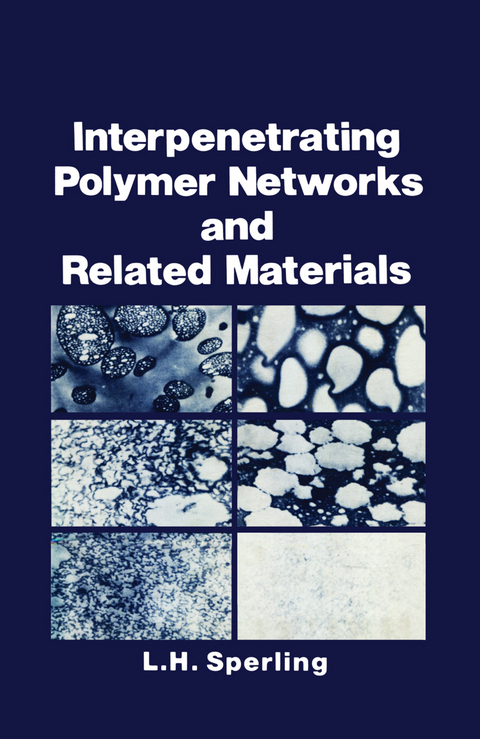
Interpenetrating Polymer Networks and Related Materials
Springer-Verlag New York Inc.
978-1-4684-3832-1 (ISBN)
1. An Introduction to Polymer Networks and IPNs.- 1.1. On the Nature of a Crosslink.- 1.2. Definition of an Interpenetrating Polymer Network.- 1.3. Historical Development of IPNs.- 1.4. A Researcher’s Approach to IPNs.- Suggested Reading. Bibliography of Selected Polymer Books.- 2. Phase Separation and Mechanical Behavior of Multicomponent Polymer Systems.- 2.1. Introduction.- 2.2. Polymer I/Polymer II Incompatibility.- 2.3. Polymer/Polymer Phase Diagrams.- 2.4. Morphology of Two-Phased Systems.- 2.5. More Complex Materials.- 2.6. On Determining Phase Continuity.- 2.7. Mechanical Behavior of Two-Phased Systems.- 2.8. Applications of Polymer Blends, Grafts, and Blocks.- Suggested Reading. Recent Multicomponent Polymer Books.- 3. A Nomenclature for Multipolymer Systems.- 3.1. Existing Nomenclature.- 3.2. Introduction to the New System.- 3.3. Nomenclature in this Work.- 3.4. Abbreviations and Jargon.- Appendix 3.1. Examples of the Proposed Nomenclature.- Appendix 3.2. Relating the New System to the Old.- 4. Homo-IPNs as Model Networks.- 4.1. Polystyrene/Polystyrene IPNs.- 4.2. Development of Theory.- 4.3. Relative Network Continuity and Physical Crosslinks.- 5. Synthesis of IPNs and Related Materials.- 5.1. Introduction.- 5.2. Sequential IPNs.- 5.3. Latex Interpenetrating Elastomeric Networks (IENs).- 5.4. Latex IPNs.- 5.5. Simultaneous Interpenetrating Networks (SINs).- 5.6. AB-Crosslinked Polymers (ABCPs).- 5.7. Thermoplastic IPNs.- 6. Morphology and Glass Transition Behavior.- 6.1. Introduction.- 6.2. Molecular Control of Morphology.- 6.3. Morphology via Optical Microscopy.- 6.4. Morphology via Transmission Electron Microscopy.- 6.5. Quantitative Expressions for Phase Domain Size.- 6.5.1. Block Copolymers and ABCPs.- 6.5.2. Sequential IPNs and Semi-IPNs.- 6.6. InducedMorphological Changes.- 6.7. Physical and Glass Transition Behavior.- 6.8. Transition Layer Thickness.- 6.9. Phase Continuity Evaluation via Modulus.- 6.10. The Interpenetration Problem.- 7. Engineering, Mechanical, and General Behavior.- 7.1. Introduction.- 7.2. Filled Interpenetrating Polymer Networks.- 7.3. Ultimate Behavior.- 7.4. Electrical and Barrier Properties.- 7.5. Ionically Charged IPNs.- 7.6. Gradient IPNs.- 7.7. Vulcanized Rubber/Rubber Blends.- 8. Actual or Proposed Applications.- 8.1. Reinforced Elastomers.- 8.2. Sheet Molding Compounds.- 8.3. Dynamically Partly Cured Thermoplastic Elastomer Blends.- 8.4. Use of Graded Rubber Latexes with Surface Functionality in Thermosets.- 8.5. Dental Fillings.- 8.6. Graft Copolymerization onto Leather.- 8.7. Thermoplastic IPNs.- 8.8. Noise- and Vibration-Damping Materials.- 8.9. Coatings and Adhesives.- 8.10. Miscellaneous IPN Patents and Studies.- 8.11. Summary of Applications.- Annotated Bibliography.
| Zusatzinfo | XI, 265 p. |
|---|---|
| Verlagsort | New York, NY |
| Sprache | englisch |
| Maße | 152 x 229 mm |
| Themenwelt | Sachbuch/Ratgeber ► Natur / Technik ► Garten |
| Naturwissenschaften ► Chemie ► Anorganische Chemie | |
| Naturwissenschaften ► Chemie ► Organische Chemie | |
| Naturwissenschaften ► Chemie ► Physikalische Chemie | |
| Technik ► Maschinenbau | |
| ISBN-10 | 1-4684-3832-8 / 1468438328 |
| ISBN-13 | 978-1-4684-3832-1 / 9781468438321 |
| Zustand | Neuware |
| Haben Sie eine Frage zum Produkt? |
aus dem Bereich


